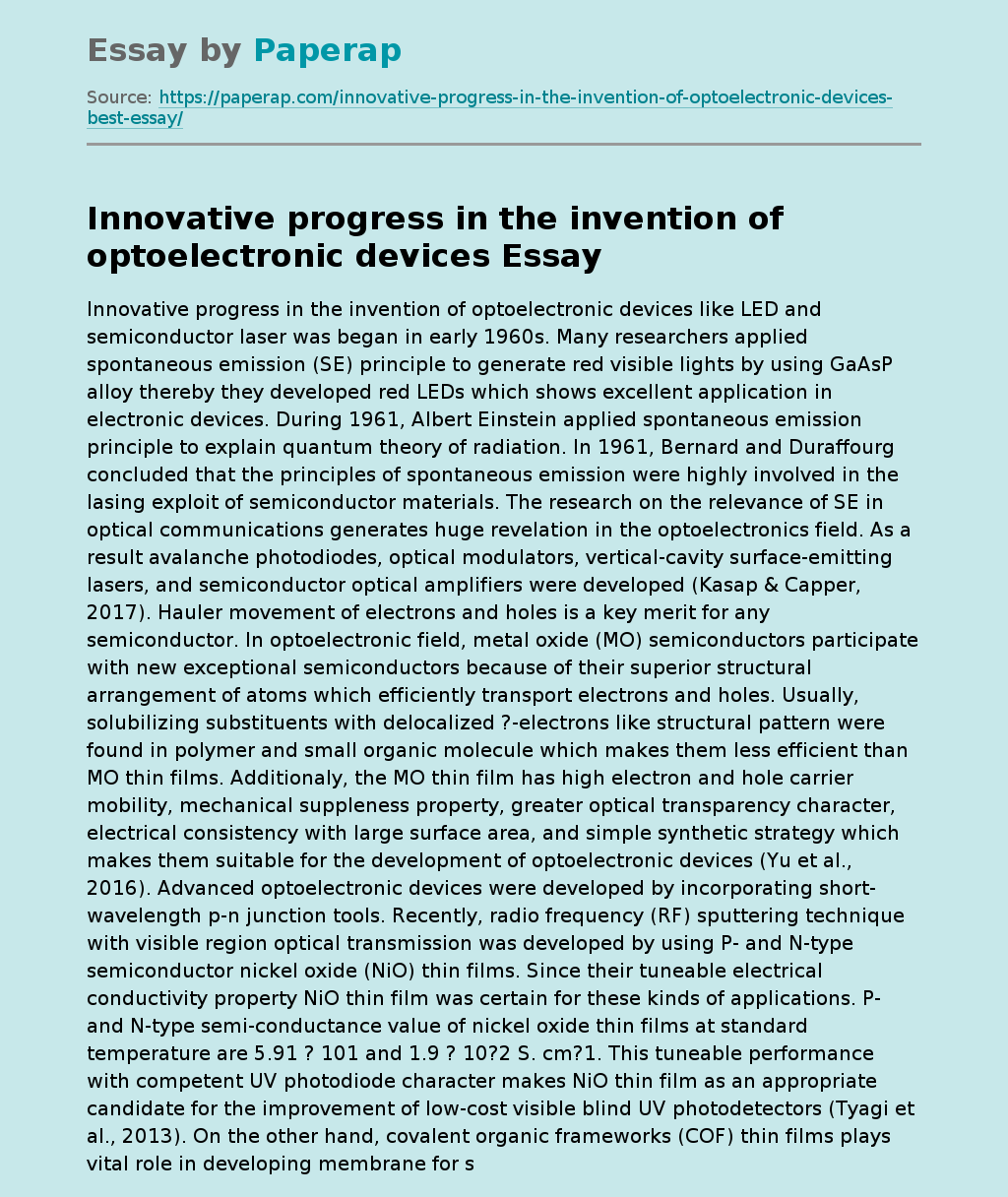Progress in the Invention of Optoelectronic Devices
The following sample essay on Innovative progress in the invention of optoelectronic devices like LED and semiconductor laser was began in early 1960s. Many researchers applied spontaneous emission (SE) principle to generate red visible lights by using GaAsP alloy thereby they developed red LEDs which shows excellent application in electronic devices. During 1961, Albert Einstein applied spontaneous emission principle to explain quantum theory of radiation. In 1961, Bernard and Duraffourg concluded that the principles of spontaneous emission were highly involved in the lasing exploit of semiconductor materials.
The research on the relevance of SE in optical communications generates huge revelation in the optoelectronics field. As a result avalanche photodiodes, optical modulators, vertical-cavity surface-emitting lasers, and semiconductor optical amplifiers were developed (Kasap & Capper, 2017). Hauler movement of electrons and holes is a key merit for any semiconductor. In optoelectronic field, metal oxide (MO) semiconductors participate with new exceptional semiconductors because of their superior structural arrangement of atoms which efficiently transport electrons and holes.
Usually, solubilizing substituents with delocalized ?-electrons like structural pattern were found in polymer and small organic molecule which makes them less efficient than MO thin films.
Additionaly, the MO thin film has high electron and hole carrier mobility, mechanical suppleness property, greater optical transparency character, electrical consistency with large surface area, and simple synthetic strategy which makes them suitable for the development of optoelectronic devices (Yu et al., 2016). Advanced optoelectronic devices were developed by incorporating short-wavelength p-n junction tools. Recently, radio frequency (RF) sputtering technique with visible region optical transmission was developed by using P- and N-type semiconductor nickel oxide (NiO) thin films.
Since their tuneable electrical conductivity property NiO thin film was certain for these kinds of applications. P- and N-type semi-conductance value of nickel oxide thin films at standard temperature are 5.91 ? 101 and 1.9 ? 10?2 S. cm?1. This tuneable performance with competent UV photodiode character makes NiO thin film as an appropriate candidate for the improvement of low-cost visible blind UV photodetectors (Tyagi et al., 2013).
On the other hand, covalent organic frameworks (COF) thin films plays vital role in developing membrane for separation, sensors for chemical vapour detection, and optoelectronic devices. The gas separation property of COF was enhanced by thin coating of Metal oxide frameworks (MOF) over COF. The formed COF composite membrane exhibits higher separation selectivity for H2/CO2 gas. Analogous to h-BN/g-C3N4 composites, wang et al., (2019) reported the graphitic carbon nitride incorporated COF thin films (g-C3N4) which ensemble for the photocatalytic deprivation of COF in favour of organic pollutants. Then again, zinc oxide thin films with elevated visible region optical transmittance and electrical properties have likelihood to use them in sensors, optoelectronics, and electronics materials in photovoltaic function. Also, zinc oxide was considered as an estimable semiconductor (SC) material for the solar cell owing to its higher binding energy (60 meV, excitation), elevated electron movement (transparent electrodes in electronics displays), chemical dependability, and thermal steadiness. ZnO thin films with adverse ZnO spacious band gap unfasten the possibility of generating ultraviolet (UV) light emission diodes (LEDs) and white REDs. (Al-Rashedi et al., 2016).
Progress in the Invention of Optoelectronic Devices. (2019, Nov 21). Retrieved from https://paperap.com/innovative-progress-in-the-invention-of-optoelectronic-devices-best-essay/

